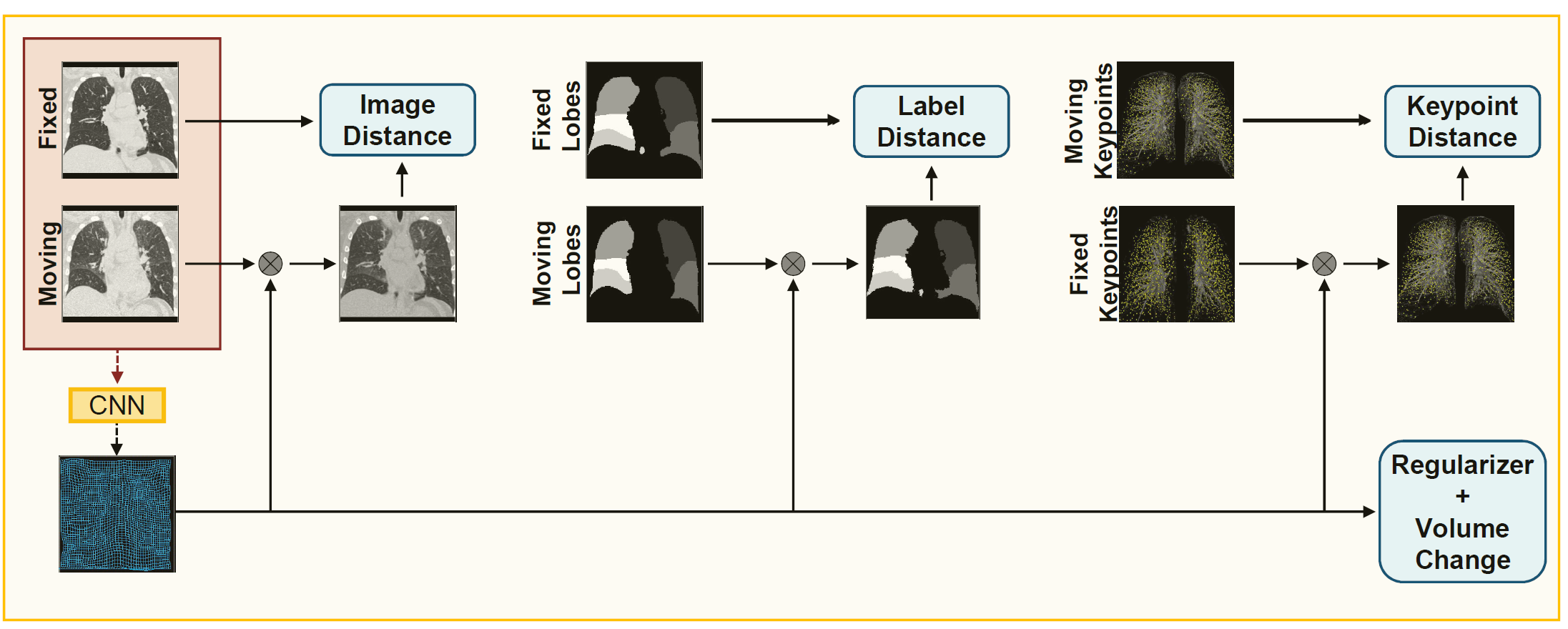Deep-Learning-Based CT Lung Registration

About
Image Version:
fb3bf078-ba1e-417b-a138-58745e96c4cc
Last updated:
Sept. 3, 2021, 7:01 a.m.
Associated publication:
Hering A, Häger S, Moltz J, Lessmann N, Heldmann S, van Ginneken B. CNN-based lung CT registration with multiple anatomical constraints. Medical Image Analysis. 2021;72:102139.
Interfaces
This algorithm implements all of the following input-output combinations:
|
Inputs |
Outputs |
| 1 |
-
- Description
- The target image for registration
- Kind
- Image
- Read from
-
/input/images/fixed/<uuid>.mha or
/input/images/fixed/<uuid>.tif
Fixed Image
-
- Description
- The image that will be warped during registration to the fixed image
- Kind
- Image
- Read from
-
/input/images/moving/<uuid>.mha or
/input/images/moving/<uuid>.tif
Moving Image
-
- Description
- Mask of the locations in the fixed image to consider
- Kind
- Segmentation
- Read from
-
/input/images/fixed-mask/<uuid>.mha or
/input/images/fixed-mask/<uuid>.tif
Fixed Mask
-
- Description
- Mask of the locations in the moving image to consider
- Kind
- Segmentation
- Read from
-
/input/images/moving-mask/<uuid>.mha or
/input/images/moving-mask/<uuid>.tif
Moving Mask
|
-
- Description
- The target image for registration
- Kind
- Image
- Write to
-
/output/images/fixed/<uuid>.mha or
/output/images/fixed/<uuid>.tif
Fixed Image
-
- Description
- The moving image warped to the fixed image
- Kind
- Image
- Write to
-
/output/images/warped/<uuid>.mha or
/output/images/warped/<uuid>.tif
Warped Image
-
- Description
- Displacement vectors to align the moving image to the fixed image
- Kind
- Image
- Write to
-
/output/images/displacement-field/<uuid>.mha or
/output/images/displacement-field/<uuid>.tif
Displacement Field
|
Model Facts
Summary

This deep-learning-based lung registration developed in [1] uses multiple anatomical constraints to supervise the training. For preprocessing, the lung mask of the inspiration and expiration scan are required. The algorithms will crop the input images to the lung regions and outputs:
cropped fixed image
warped moving image
displacement field in mm
For further questions or comments please contact us at alessa.hering@mevis.fraunhofer.de
[1] Hering, A., Häger, S., Moltz, J., Lessmann, N., Heldmann, S., & van Ginneken, B. (2021). CNN-based Lung CT Registration with Multiple Anatomical Constraints. Medical Image Analysis, 102139.
Mechanism
Left empty by the Algorithm Editors
Validation and Performance
Left empty by the Algorithm Editors
Uses and Directions
This algorithm was developed for research purposes only.
Warnings
Left empty by the Algorithm Editors
Common Error Messages
Left empty by the Algorithm Editors
Information on this algorithm has been provided by the Algorithm Editors,
following the Model Facts labels guidelines from
Sendak, M.P., Gao, M., Brajer, N. et al.
Presenting machine learning model information to clinical end users with model facts labels.
npj Digit. Med. 3, 41 (2020). 10.1038/s41746-020-0253-3



